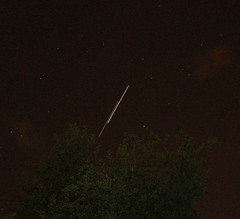Orbits can be a bit complicated. As the International Space Station orbits the Earth every 90 minutes or so, the Earth is spinning underneath it… and not only that, the orbit of the ISS is tilted by about 50 degrees to the Equator. All of this means that any one spot on Earth doesn’t see the ISS every 90 minutes, and in fact it can be days or weeks between favorable overhead passes.
To help you figure all this out, NASA has created a nifty applet to help you determine when the ISS (and a handful of other satellites, including Hubble) are visible at your location. You can enter your country or zip code and it will tell you when the next visible pass of the ISS occurs. You may have to click “Next Sighting” a few times to get one that’s at a decent time, but keep at it.
 |
| ISS and the Shuttle rising over the trees. I shot this picture in 2007. |
This application also provides you with a map of the sky to help you out.
And while it’s nice and all, I still prefer to use Heavens Above, a fantastic resource on the web for satellite passes, sky mapping, and tons more. All you need to do is put in your latitude and longitude as accurately as you can (Google Maps will help there) and it will give you a table of dozens of visible satellite passes, including ISS, Hubble, and a gazillion more.
For you Americans out there, the Fourth of July is a great time for skygazing; even though the Sun doesn’t set until late, a lot of folks will be out after dark anyway. So why not stay outside a few extra minutes and watch the real fireworks?